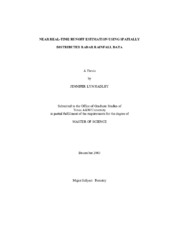Near real-time runoff estimation using spatially distributed radar rainfall data
Abstract
The purpose of this study was to evaluate variations of the Natural Resources Conservation Service (NRCS) curve number (CN) method for estimating near real-time runoff for naturalized flow, using high resolution radar rainfall data for watersheds in various agro-climatic regions of Texas. The CN method is an empirical method for calculating surface runoff which has been tested on various systems over a period of several years. Many of the findings of previous studies indicate the need to develop variations of this method to account for regional and seasonal changes in weather patterns and land cover that might affect runoff. This study seeks to address these issues, as well as the inherent spatial variability of rainfall, in order to develop a means of predicting runoff in near real-time for water resource management. In the past, raingauge networks have provided data for hydrologic models. However, these networks are generally unable to provide data in real-time or capture the spatial variability associated with rainfall. Radar networks, such as the Next Generation Weather Radar (NEXRAD) of the National Weather Service (NWS), which are widely available and continue to improve in quality and resolution, can accomplish these tasks. In general, a statistical comparison of the raingauge and NEXRAD data, where both were available, shows that the radar data is as representative of observed rainfall as raingauge data. In this study, watersheds of mostly homogenous land cover and naturalized flow were used as study areas. Findings indicate that the use of a dry antecedent moisture condition CN value and an initial abstraction (Ia) coefficient of 0.1 produced statistically significant results for eight out of the ten watersheds tested. The urban watershed used in this study produced more significant results with the use of the traditional 0.2 Ia coefficient. The predicted results before and during the growing season, in general, more closely agreed with the observed runoff than those after the growing season. The overall results can be further improved by altering the CN values to account for seasonal vegetation changes, conducting field verification of land cover condition, and using bias-corrected NEXRAD rainfall data.
Citation
Hadley, Jennifer Lyn (2003). Near real-time runoff estimation using spatially distributed radar rainfall data. Master's thesis, Texas A&M University. Texas A&M University. Available electronically from https : / /hdl .handle .net /1969 .1 /346.


